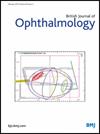CorvisST biomechanical indices in the diagnosis of corneal stromal and endothelial disorders: an artificial intelligence-based comparative study.
IF 3.5
2区 医学
Q1 OPHTHALMOLOGY
引用次数: 0
Abstract
AIMS To analyse the value of the CorvisST indices in diagnosing corneal stromal and endothelial disorders (CSEDs). METHODS This institutional retrospective case-control study included 903 eyes with a CSED and 597 normal eyes (controls), assessed with CorvisST and MS39. MAIN OUTCOME MEASURES CorvisST indices. The collected data were divided into a training set (70%) and a test set (30%). Artificial intelligence frameworks were used to distinguish each disorder from controls and to classify corneas into seven groups: keratoconus, high-risk corneas for keratoconus, laser corneal refractive surgery (LCRS), endothelial disorders, stromal opacities, glaucoma corneas and normal corneas. RESULTS Stress-strain index (SSI) significantly increased with age in the control group. Compared with controls matched for age/sex, keratoconus was associated with Corvis Biomechanical Index (CBI) >0.51 (area under the curve, 0.99), Ambrósio's relational thickness horizontal (ARTh) <425.5 (0.97), deflection amplitude at the time of the first applanation (SPA-A1) <96.3 (0.97) and Pachy<522.4 µm (0.91); high-risk corneas with a difference in CBI between fellow eyes (CBI SYM) >0.14 (0.98), (L2) <1.95 (0.83) and Pachy<549.7 µm (0.71); LCRS with ARTh<455.1 (0.93) and CBI>0.35 (0.83); corneal endothelial disorders with Pachy SYM>19.7 µm (0.83), Pachy>569.1 µm (0.82) and CBI SYM>0.14 (0.77); stromal opacities with SPA-A1 SYM>11.8 (0.92), ARTh<569.9 (0.89), SSI SYM>0.14 (0.89) and CBI>0.22 (0.86). A logistic regression function using all indices reached an area under the receiver operating characteristic curve of 0.81 for glaucoma diagnosis. The TabPFN model provided the best accuracy (88.7%) for diagnosing the seven corneal conditions. SSI, SPA-A1, CBI and Pachy correlated with keratoconus grade. Keratoplasty for keratoconus improved but failed to restore normal corneal biomechanics. CONCLUSIONS CorvisST indices are relevant for diagnosing CESDs and distinguishing various disorders from each other.CorvisST生物力学指标在角膜基质和内皮疾病诊断中的应用:一项基于人工智能的比较研究。
目的分析CorvisST指标在角膜基质与内皮疾病(CSEDs)诊断中的价值。方法本研究纳入903只CSED眼和597只正常眼(对照),采用CorvisST和MS39进行评估。主要观察指标:观察指标。将收集到的数据分为训练集(70%)和测试集(30%)。使用人工智能框架将每种疾病与对照组区分开来,并将角膜分为7组:圆锥角膜、圆锥角膜的高危角膜、激光角膜屈光手术(LCRS)、内皮疾病、间质混浊、青光眼角膜和正常角膜。结果对照组的应力应变指数(SSI)随年龄的增长而显著升高。与年龄/性别匹配的对照组相比,圆锥角膜与Corvis生物力学指数(CBI) >相关0.51(曲线下面积,0.99),Ambrósio相关厚度水平(ARTh) 0.14 (0.98), (L2) 0.35 (0.83);角膜内皮病变为Pachy SYM>19.7µm(0.83)、Pachy>569.1µm(0.82)和CBI SYM>0.14 (0.77);SPA-A1 SYM>为11.8 (0.92),ARTh0.14 (0.89), CBI>为0.22(0.86)。使用所有指标的logistic回归函数在青光眼诊断的受试者工作特征曲线下的面积达到0.81。TabPFN模型对7种角膜病变的诊断准确率最高(88.7%)。SSI、SPA-A1、CBI、Pachy与圆锥角膜分级相关。圆锥角膜的角膜移植术改善了角膜的生物力学,但未能恢复正常。结论scorvisst指标对慢性阻塞性肺疾病的诊断和各种疾病的鉴别具有重要意义。
本文章由计算机程序翻译,如有差异,请以英文原文为准。
求助全文
约1分钟内获得全文
求助全文
来源期刊
CiteScore
10.30
自引率
2.40%
发文量
213
审稿时长
3-6 weeks
期刊介绍:
The British Journal of Ophthalmology (BJO) is an international peer-reviewed journal for ophthalmologists and visual science specialists. BJO publishes clinical investigations, clinical observations, and clinically relevant laboratory investigations related to ophthalmology. It also provides major reviews and also publishes manuscripts covering regional issues in a global context.

 求助内容:
求助内容: 应助结果提醒方式:
应助结果提醒方式:


